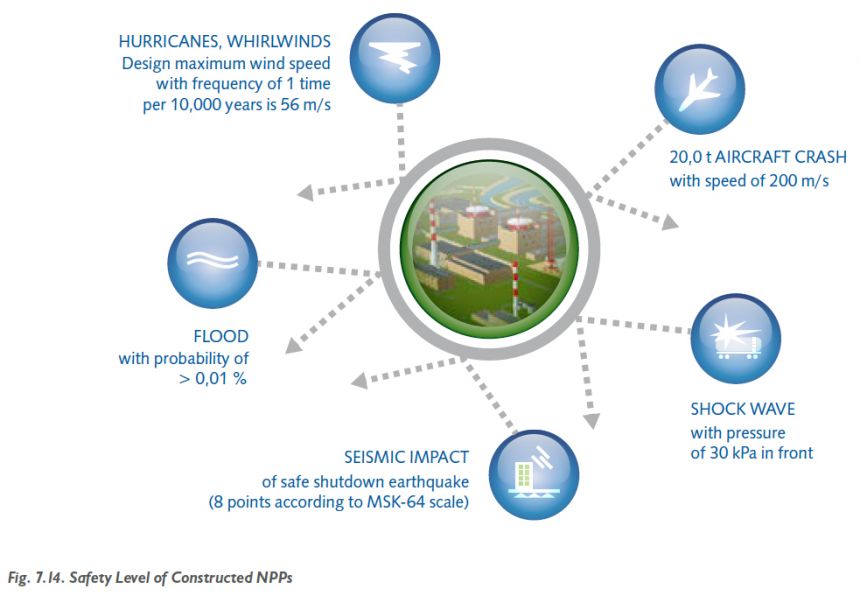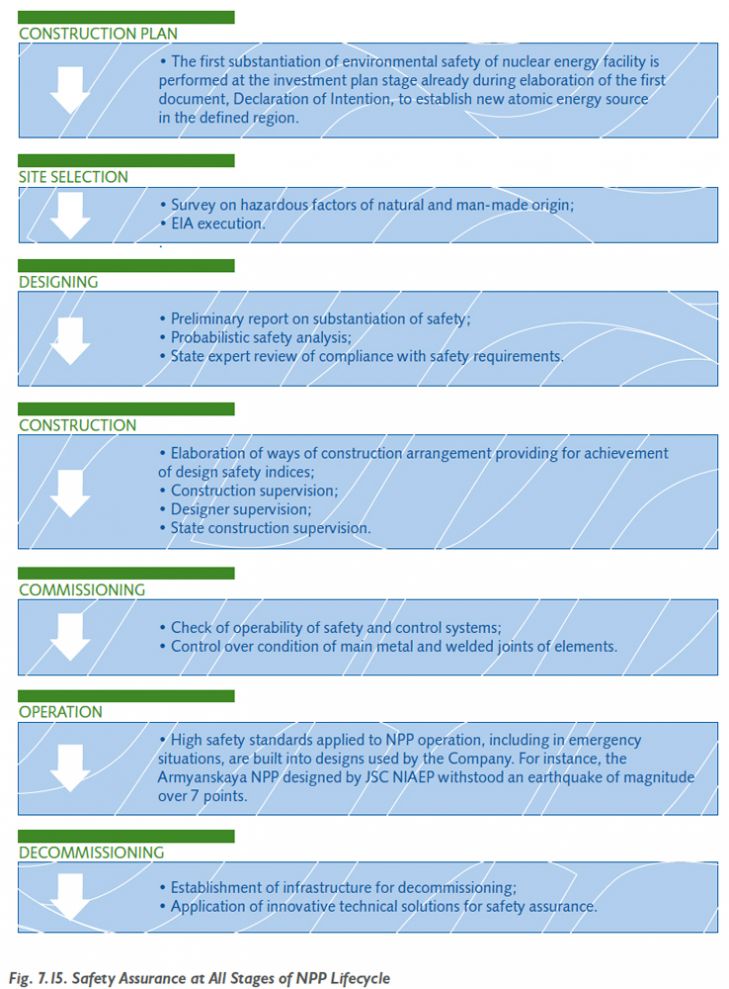During construction of NPP generating units NIAEP executes project complying with all safety norms and requirements of the Russian Federation. In addition, NIAEP takes into account modern principles and approaches to safety assurance established by IAEA norms.
In terms of nuclear and radiation safety minimization of negative environmental impact of completed nuclear power industry facilities is achieved through sound elaboration of design documentation and compliance with its requirements in the process of construction.
NPP construction and operation is regulated by the following regulatory documents:
- Federal Law No. 170 on Nuclear Energy Use of November 21, 1995;
- Federal Law No. 3 on Radiation Safety of Population of January 9, 1996;
- Federal Law No. 190 on Radioactive Waste Handling of July 11, 2011;
- Provision on Licensing of Activity in the Field of Nuclear Energy Use;
- Rules of Physical Protection of Nuclear Materials, Nuclear Units and Storage Stations for Nuclear Materials;
- Provision on Elaboration and Approval of Federal Norms and Rules in the Field of Nuclear Energy Use and Lists of Federal Norms and Rules in the Field of Nuclear Energy Use;
- Rules on Decision Making on Location and Construction of Nuclear Facilities, Radiation Sources and Storage Stations;
- Federal Norms and Rules in the Field of Nuclear Energy Use;
- Sanitary Norms and Rules of Radiation Safety Assurance.
The requirements of regulatory documentation are complied with both during elaboration of design documentation and at the following stages: NPP construction, operation and decommissioning.
Fig. 7.14. Safety Level of Constructed NPPs

Technical Solutions for Safety Assurance
Nuclear power stations are designed with a significant margin of stability to internal and external impacts.
NPP safety in respect of internal (radiation) impacts is achieved through consecutive execution of concept of defense in depth based on application of physical barrier system mounted on the way of distribution of ionizing radiation and radioactive substances to the environment. In addition, a complex of technical and organizational measures is executed on protection of barriers and maintenance of their effectiveness, as well as on staff, population and environment protection.
Organizational Issues of Safety Assurance
Fig. 7.15. Safety Assurance at All Stages of NPP Lifecycle

Assessment of Products and Services Safety and Impact on Health
Assessment of NPP impact on human health and environmental protection is carried out at each stage of NPP lifecycle, including:
- Selection of site;
- Designing;
- Construction;
- Commissioning;
- Operation;
- Modernization.
The methods of the current Management System of the Integrated Company are applied on a case-by-case basis with consideration of:
- Influence of equipment, systems and structures or type of activity on NPP safety;
- Values and complexity of each type of equipment, systems and structures or activity;
- Possible consequences of product defects or improper performance of activity.

NPP complies with safety requirements, if its radiation impact on staff, population and environment during normal operation and abnormal operation, including design-basis accidents, does not lead to excess of admissible staff and population irradiation doses, standard levels of emissions and discharges, concentration of radioactive substances in environment, and is restricted in case of beyond design-basis accidents. This is achieved through compliance with requirements of federal norms and rules in the field of nuclear energy use, IAES standards, and other regulatory documents.
Substantiation of environmental safety of nuclear energy facilities begins at the stage of investment plan and is formalized in the Declaration of Intention on creation of new atomic energy source. The main tasks on environmental impact assessment are solved at the stage of design. Environmental safety of NPP designed for construction in Russia is proved through comparison of design indices and indices achieved during operation of similar generating units with admissible indices set by applicable norms.
For instance, according to one of the applicable standards “Sanitary Rules of Designing and Operation of Nuclear Stations” (SP AS-03), the main irradiation dose limit for population in conditions of normal operation amounts on the average to 1 mSv for life time of 70 years. This index is built into the design of Rostov NPP generating units 3 and 4 with a value of 10 mkSv per year (i.e. 0.01 mSv per year), which is 100 times lower than the effective standard. The actual level of radiation from the running unit 1 of the Rostov NPP is still 100 times lower than the estimated design values, i.e. it presents a markup to the natural radiation background in the area of Volgodonsk which is almost imperceptible for radiation survey meters (natural radiation background amounts to 1 mSv per year). Even in cases of hypothetical beyond design-basis accidents the estimated radiation values will not exceed 100 mkSv per year (10% of admissible limits).
The design documentation elaborated for NPP generating unit after procurement of necessary permits is subject to mandatory independent analysis. It is required to obtain licenses of the Federal Service for Environmental, Technological and Nuclear Supervision for each stage of NPP lifecycle (4 licenses for each generating unit). In turn, materials on license substantiation shall be prepared, in order to procure each license (on the basis of environmental impact assessment). The necessary requirement for materials on license substantiation consists in that all interested parties, public and scientific organizations shall have access to these materials. After a preliminary review, public hearings shall be held on EIA materials in respect of designed facility in the region of planned construction. Following positive conclusion from the state environmental expert review, the materials on license substantiation are subject to additional special expertise carried out by the Scientific and Engineering Center for Nuclear and Radiation Safety (SEC NRS), i.e. analysis of nuclear and radiation safety with consideration of all other factors, including environmental, fire, etc.

After a SEC NRS expert analysis, the Federal Service for Environmental, Technological and Nuclear Supervision issues licenses for a certain stage of NPP lifecycle: placement, construction, operation or decommissioning. Currently, NIAEP received licenses for placement of Nizhny Novgorod NPP generating units 1 and 2, Tver NPP generating units 1 and 2, and operation of Kalinin NPP generating unit 4.
In 2012 EIA materials were elaborated for operation of Rostov NPP generating unit 3. In December 2012 the specified materials, first separately, and then as part of materials on license substantiation (MLS) were submitted for public hearing and further public discussion in the Dubovskoye Settlement and Volgodonsk Town of the Rostov Region. In 2012 the NIAEP activity complied with all norms and safety requirements of the Russian Federation and IAEA.